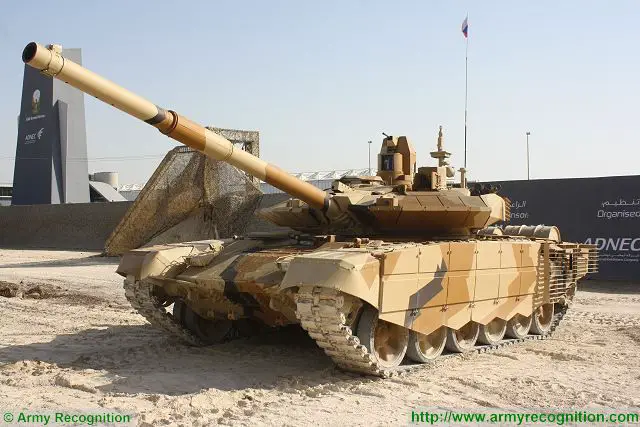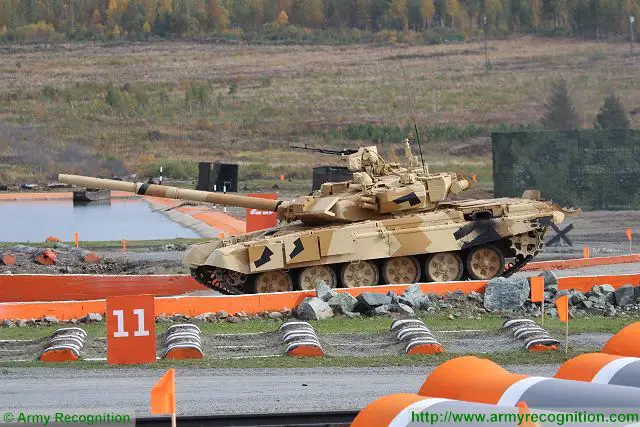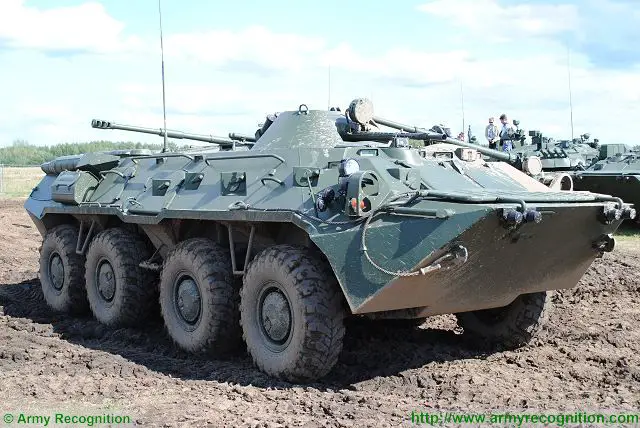Analysis about the Russian armoured vehicles and tanks in the global military market 12703161
|
|
|||
|
Military Defense Industry Technology - Russian armoured vehicles
|
|||
|
|
|||
| Analysis about the Russian armoured vehicles and tanks in the global military market. | |||
|
As of early 2016, three Russian defense industry companies were suppliers of various armoured vehicles to both domestic and international markets. Scientific-research corporation Uralvagonzavod (Russian acronym: UVZ) offers T-90S, T-90MS and upgraded T-72 main battle tanks, BMP-T / Terminator-2 fire support vehicles (FSV), BMR-3M mine clearance vehicles, BREM-1M armoured repairing vehicles (ARV).
|
|||
|
|
|||
 Russian-made T-90MS main battle tank at IDEX 2013 defense exhibition in Abu Dhabi, United Arab Emirates Russian-made T-90MS main battle tank at IDEX 2013 defense exhibition in Abu Dhabi, United Arab Emirates |
|||
|
|
|||
| The military department of the Tractor Plants concern produces BMP-3 / BMP-3M infantry fighting vehicles (IFV), BREM-L ARVs, BMD-4M airborne infantry fighting vehicles and BTR-MDM armoured personnel carriers (APC). Military-Industrial Company (Russian acronym: VPK, a subsidiary of Bazovy Element Group) manufactures BTR-80 / BTR-80A / BTR-82 / BTR-82A APCs, BREM-K ARVs and AMN-233114 Tigr-M multi-purpose 4x4 utility vehicles. The aforementioned companies are the core of Russian armoured vehicles production. Since 2001, the interest of foreign customers to Russian MBTs has significantly increase. According to the Stockholm International Peace Research Institute`s (SIPRI) arms transfers database, in 2001-2015, Russia exported 1,416 T-90S tanks (both ready-to-use and kits for local licensed assembly) of 2,316 ordered MBTs. The T-90S local production lines were established in India and Algeria. India still remains the most substantial foreign operator of Russian T-90S tanks. Within the prescribed period, this country received 947 MBTs (including 761 locally assembled from kits supplied by UVZ). As of early 2016, Russia had to supply approximately 710 T-90S tanks to India. Algeria got about 315 T-90SA tanks ("A' stands for Algerian) equipped with improved air conditioning unit. The North African country is to assemble about 190 MBTs. In early 2016, Russia almost finished the deliveries of 100 T-90S tanks equipped with Shtora-1 optical-electronic jamming system to Azerbaijan. Ten MBTs of such type were supplied to Turkmenistan in 2009-2012. Uganda received 44 T-90S tanks in 2011. |
|||
|
|
|||
 Russian-made T-90S main battle tank at RAE 2015 defense exhibition in Nizhny Tagil, Russia. Russian-made T-90S main battle tank at RAE 2015 defense exhibition in Nizhny Tagil, Russia. |
|||
|
|
|||
|
T-90S and its modification still remain in high demand by perspective foreign customers. During the Russia Arms Expo 2015 (RAE-2015) several Arabic states revealed their keen interest to the acquisition of T-90S and T-90MS tanks. When the coalition led by Saudi Arabia started intervention to Yemen to fight Housit rebels, Western-originated armoured vehicles were found to unreliable and not able to effectively fight in desert and desert-mountain regions. According to several reports, the chassis AMX-56 Leclerc MBTs deployed by United Arab Emirates faced with several technical difficulties during the intervention, while Leclerc revealed its high firepower performance. Saudi Arabia deployed at Yemen the US-originated M1A2 Abrams tanks. Houthis eliminated several M1A2s, using ageing Soviet 9M111 Fagot (NATO reporting name: AT-4 Spigot) and 9M113 Konkurs (AT-5 Spandrel) anti-tank guided missiles (ATGM).
In such conditions, the Arabic nations have shown their interest to the potential acquisition of T-90MS, the latest modification of T-90S. It retains the high serviceability and maintainability of its predecessor, while the tank`s firepower and protection have been significantly increased compared to basic T-90S. T-90MS has received Relict explosive reactive armour (ERA) system developed by NII Stali. It is installed on the frontal armour plate, the sides and the turret of the upgraded MBT, increasing its survivability on the modern battlefield. As the war in Syria demonstrated, the Relict`s predecessor, Kontakt-5 (basic ERA of T-90A/T-90S) armour could successfully resist to TOW-2A/B BGM-71E and BGM-71F ATGMs. Relict is reported to be 50% more effective, than Kontakt-5. T-90MS retains 2A46M-5 gun-launcher, which could fire both standard 125mm anti-tank/anti-personnel rounds and 9M119M/9M119M-1 Invar/Invar-M1 ATGMs. |
|||
|
|
|||
 Russian BMP-3 armoured infantry fighting vehicle at military parade in Moscow (Source Wikimedia) |
|||
|
|
|||
|
Russian IFV are also highly demanded by potential foreign customers. During the RAE-2015 show, the Arabic states revealed their interest to the latest modification of world-known BMP-3, namely, BMP-3 Derivatsiya (Derivation).
In 2001-2015, Russia delivered BMP-3 / BMP-3M armoured vehicles to the foreign customers. Azerbaijan got about 100 upgraded BMP-3M IFVs. Indonesia received 54 BMP-3Fs in naval configuration for the national Marine Corps. The deliveries of 70 upgraded BMP-3Ms to Kuwait had been finished by end-2015. South Korea received 37 BMP-3s in basic configuration in 2005-2006. Six BMP-3s were supplied to Turkmenistan. Venezuela had received 123 BMP-3Ms and BREM-L ARVs by end-2015. Basic BMP-3 / BMP-3M has an outstanding firepower, estimated to be the best in its class. The vehicle is equipped with 100mm 2A70 gun-launcher, which could fire 3UOF17 and 3UOF19 high-explosive (HE) shells and 9M117 Bastion (AT-10 Stabber/AT-12 Swinger) ATGMs, and with 30mm 2A72 automatic gun. Such combination allows to effectively support dismounted troops on the modern battlefield. Basic BMP-3 lacks side armour (compared to Western analogues), but the installation of additional armour plates and Kaktus ERA provide sufficient protection from small-caliber automatic guns and ATGMs. BMP-3 could be upgraded with Arena-E active protection system (APS). At the same time, NATO nations are developing new small-caliber (up to 40mm) guns, which could penetrate over 100 mm of steel armour, using kinetic projectile (not shape-charge warheads). In 2014, CTA International company developed 40mm 40 CTAS (CT cannon). It fires advanced armour-piercing fin-stabilized discarding sabot - tracer (APFSDS-T) rounds, being able to pierce more than 140mm of rolled homogeneous armour (RHA) at 1,500 m. Such shell can penetrate the armour protection of light armoured vehicles, IFVs and even side armour plates of modern MBTs. The newest Western IFV (for instance, British Ajax and French VBCI) can be armed with CT cannon. At the Eurosatory-2014 defense show, French Nexter Group demonstrated T40 manned combat module armed with 40 CTAS. T40 module is intended for installation on VBCI IFV. It can also be adapted for other Western armoured fighting vehicles (both tracked and wheeled). As a response to 40 CTAS cannon, Russian Tractor Plants concern developed BMP-3 Derivatsiya IFV. It is armed with 57mm naval cannon chambered for 57x348mm round. The APFSDS round fired from such cannon could easily penetrate 130-140mm of RHA at distances up to 1,800-2,000m. Hence, 40 CTAS is not the only available "small caliber-high power" IFV gun at the international arms market. Russian 57mm cannon is also effective against low-flying aerial targets and personnel (using HE round). |
|||
|
|
|||
 Russian-made BTR-80 8x8 APC Armoured Personnel Carrier at Defense Exhibition near Moscow, Russia. Russian-made BTR-80 8x8 APC Armoured Personnel Carrier at Defense Exhibition near Moscow, Russia. |
|||
|
|
|||
|
The export of BTR-80 / BTR-80A / BTR-82 / BTR-82A APCs within the prescribed period was huge despite the weak armour and anti-mine protection of the vehicles. The BTR-80A/82A APCs were demanded due to high power (unlikely Western analogues, both carriers are armed with extremely effective 30mm 2A72 automatic cannon). In 2001-2015, Russia delivered to foreign customers 1,036 of APCs of 1,068 ordered. Azerbaijan received 70 BTR-80As. About 318 basic BTR-80 were supplied to Bangladesh. Belarus ordered 32 BTR-82A APCs. Colombia got eight BTR-80 in Caribe configuration. Eight BTR-80 carriers were supplied to Djibouti. Indonesia received 12 BTR-80A. About 93 BTR-80A, 44 BTR-82A and 18 BTR-80 APCs were delivered to Kazakhstan. Mongolia received 20 BTR-80s under Russian military aid program. North Korea got 32 BTR-80As in 2000-2001. Approximately 19 BTR-80As were delivered to Sri-Lanka. Sudan got 90 BTR-80A APCs designated as Shareef-1 in Sudanese service. Eight BTR-80As were supplied to Turkmenistan. Uganda received 32 BTR-80As. About 50 basic BTR-80s were sold to Uzbekistan. Venezuela got 114 BTR-80As. About 100 BTR-80A APCs were supplied to Yemen.
The interest of foreign customers to BTR-80A / BTR-82A will be stable in the years to come, as it is a relatively inexpensive, reliable and effective APC, being able to deliver sufficient firepower to dismounted soldiers. BTR-80A / BTR-82A has an IFV firepower in an APC form-factor. The installation of spall liner and anti-blast seats on BTR-82A increases its protection from small-caliber arms, heavy splinters and land mines. The deliveries of basic BTR-80 within the prescribed period were limited, as modern Western analogues have Level 4 STANAG 4569 protection, which can resist to 14.5mm armour-piercing bullet fired from BTR-80`s KPVT machinegun. |
|||
|
|
|||
 Russian-made BTR-82A 8x8 APC Armoured Personnel Carrier at Defense Exhibition near Moscow, Russia. Russian-made BTR-82A 8x8 APC Armoured Personnel Carrier at Defense Exhibition near Moscow, Russia. |
|||


























